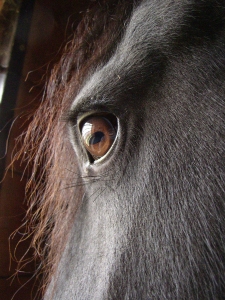 This past holiday weekend, I listened to someone announce that they had “euthanized” their problem horse (who really did need to be put down — it had a vet-diagnosed neurological condition and was aggressively dangerous). I was thinking of commending them for taking responsibility for the animal and not just selling the problem along to an unsuspecting buyer when they said they had “euthanized” the horse by selling him for slaughter. (“Bam!” they said. “Bolt to the head.”)
This past holiday weekend, I listened to someone announce that they had “euthanized” their problem horse (who really did need to be put down — it had a vet-diagnosed neurological condition and was aggressively dangerous). I was thinking of commending them for taking responsibility for the animal and not just selling the problem along to an unsuspecting buyer when they said they had “euthanized” the horse by selling him for slaughter. (“Bam!” they said. “Bolt to the head.”)
Clearly they missed out on the part where horse slaughter was not, at that time, legal in the US — before their horse was “euthanized”, it rode many hours in an open air cargo van — perhaps one designed for horses, perhaps one designed for pigs or cattle — with no food or water, to reach a slaughter plant in Canada. The horse may not have even reached the killing box and its captive bolt gun — it may have died along the way, kicked at the feedlot, crushed or trampled in the truck, or suffering from exposure or dehydration.
There is hope that things may be changing. Recently, Congress has, without fanfare, quietly lifted a five-year-old ban on funding for inspection of horse meat, which indirectly paves the way for re-opening of domestic horse slaughter plants by providing for the inspection of meat produced at those plants. There isn’t currently a budget for horse meat inspection, so the process might be slow, but people who have been witness to the issues surrounding the lack of appropriate facilities in the US are scrambling to get one going, to prevent trips like the one my acquaintance’s horse took.
The closure of domestic slaughter plants in 2007 has not resulted in a reduction of the amount of US horses being slaughtered. They are simply being trucked over the border to be slaughtered in Canada and Mexico, doing nothing but adding a 24 to 72 hour trip in a packed cargo truck — here’s animal behaviorist and slaughter reformist Temple Grandin describing one version of that experience — to the doomed horses’ woes.
We certainly do need to alter a lot of things about the process that is allowing companion horses to be slaughtered for food — including providing education for horse owners, finding help for families who, through no fault of their own, can no longer support their animals, and initiating improvements in slaughter practices and how all slaughter plants (not just ones for horses) are run. There are a lot of problems with this industry, in all countries (graphic link). However, sending horses off to Mexico and Canada is not the answer. Providing a good support network for distressed owners, increasing public education, and bringing the slaughter plants under USDA control won’t fix the problem, but would be a huge step in the right direction.

